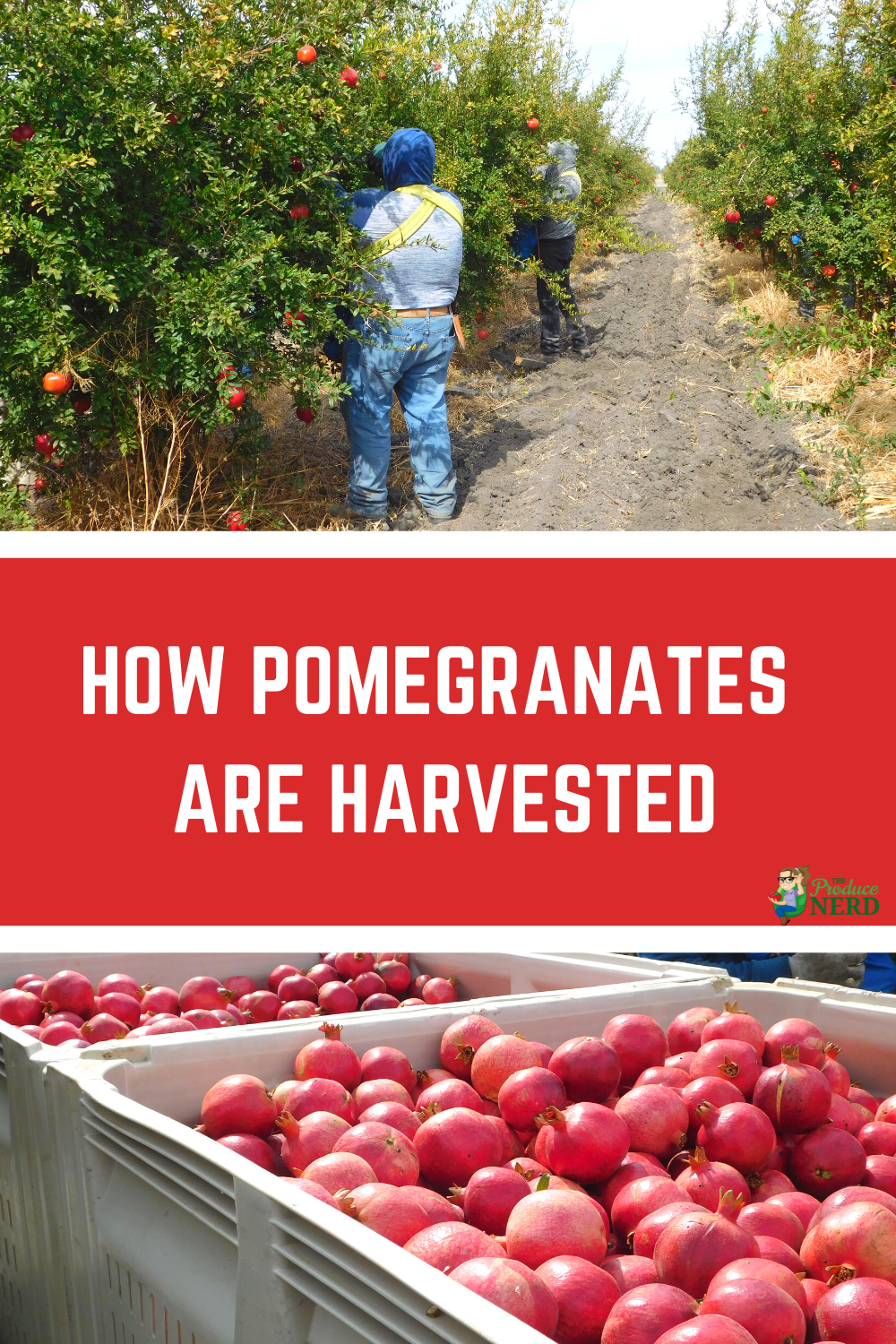Pomegranates are one of the big things to look forward to at the end of the year because they ripen in the fall. Pomegranates only have a two month harvesting window in California, which occurs between September and November. In between that two month period, all of the harvesting, packing and processing takes place. However, whole pomegranates can be stored for months after harvest.
Table of Contents
Pomegranate Cultivars
The Wonderful variety is the most popular pomegranate and is the main cultivar grown in the United States, with California being the main producer. The Granada and Foothill cultivars are also grown as an early season crop. However, there are a lot of other options that could be selected. A few years back, I attended the Pomegranate Tasting at the Wolfskill Experimental Orchard, and was able to taste and sample an array of the different pomegranate cultivars that exist. Between cultivars, there are differences in skin color, aril color, seed size, SSC (soluble solids concentration/Brix/sugars), acidity, shelf-life, flower type, etc. Some examples of the variety between cultivars are shown below.
Pomegranate Flowers
Pomegranate cultivars produce beautiful flowers, with some pomegranate varieties being purely ornamental. The flowers range from red to pink to white to orange to a mixture of red and white in color, with the ornamental trees producing larger flowers than the fruit-bearing trees.
Antioxidant Content in Pomegranates
In one research study that compared the antioxidant content of commercial pomegranate juice to green tea and red wine found that commercial pomegranate juice has approximately three times the amount of antioxidants compared to green tea and red wine. Commercial pomegranate juice consists of both portions of the arils and the rind, and contains more antioxidants compared to juice that only consists of juice from the arils.
Pomegranate Harvesting
Pomegranate harvesting is similar to that of other tree fruits. The fruit is harvested using clippers and placed into bags. (Some similar harvesting processes that you can see include avocados, mandarins and peaches.)
Not all pomegranates on the same tree are ready for harvest at the same time. Pomegranates are non-climacteric fruit and do not continue ripening after harvest, so it is important to harvest pomegranates only when they are ready. When harvesting, workers need to check the external skin color to determine ripeness. Other indicators that can be used by the grower to determine when the field (in general) is ready for harvest is to test the acidity of the juice from the arils. The harvesters also need to make sure that the pomegranates are in good condition (e.g., no splits or cracks).
How are Pomegranates Harvested?
The pomegranate harvesting process is as follows:
- Workers select pomegranates that are ready for harvest and use clippers to remove them from the tree.
- The harvested pomegranates are placed into the harvesting bags that the workers are wearing. Harvesting bags are used to prevent damage to the fruit. They also allow the workers mobility to move between the trees to harvest the ripe fruit.
- Once the bags have been filled, the workers unload the fruit into bins that are centralized in the field.
- Once the bins have been filled, they are taken to a nearby facility and a new set takes their place.
See a step-by-step of the pomegranate harvesting process below.
After the pomegranates are harvested, they are either taken to a packinghouse to be packed and sold as whole pomegranates, or they are taken to a processor to be transformed into a juice or aril product.
Food Safety Considerations
For a pomegranate harvesting operation, some of the main food safety concerns are:
- Sanitation of the harvesting tools – Tools should be cleaned and sanitized, including having a clean place to store them while the workers are on break, and the company needs to have a program in place to store the knives overnight instead of having the workers take them home with them.
- Sanitation of the harvesting bags and bins – Cleaning and sanitizing of the bags and bins needs to occur on a regular and frequent basis. In this case, they are using bags that need to be laundered (differently from how you would clean a bin or harvesting bucket).
- Glove policy – If there is a glove policy in place and/or any workers choose to wear gloves, there needs to be a policy in place for cleaning and/or replacing the gloves on a frequent basis.
There are many more items to be taken into consideration, but this is just a brief list to get you thinking about it! Also, something to consider is that harvested pomegranates go to both the packing house to be packed whole, and to the processor to be broken down to arils or into some form of juice product.
Postharvest Considerations
Pomegranates can last in cold storage for more than two months after being harvested. However, they are susceptible to chilling injury if stored in too cold of a temperature range. They can also experience dark discoloration on the husk (referred to as husk scald), which only affects the exterior of the fruit if stored at improper temperature conditions for a long period of time.
Answering Common Pomegranate Questions
Are pomegranates harvested by hand or with a harvesting tool?
Workers use clippers to harvest pomegranates.
How to eat a pomegranate?
You can eat them fresh, by removing the arils or buying packaged arils, in juice (made at home or purchased at the store), in jellies, salsas and whatever else your heart desires!
When is pomegranate season?
In the United States, pomegranates are mainly grown in California. The growing season for pomegranates is in the winter months, with the harvesting window between September and November.
Can you eat the seeds in pomegranate arils?
Yes, you can eat the seeds in pomegranate arils.
How do you know if a pomegranate is ripe?
Pomegranate ripeness is dependent on the cultivar, but common maturity indices are the color of the skin and juice, and the acidity of the juice. You can click here to learn more about how to select and store pomegranates.
Do pomegranates continue ripening after harvest?
No, pomegranates are non-climacteric fruit and do not continue ripening after harvest.
Featured Grower Information
I would like to thank Crivelli Farms for the visit, and for allowing the pomegranate harvesting footage to be shared. Crivelli Farms is located in Los Banos, California, and they grow pomegranates, corn (for processing and for corn silage), cotton and many other crops.
If you enjoyed this post, you might also like:


Easy and effective way to remove pomegranate arils. Super easy. Great job ! Thanks.